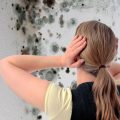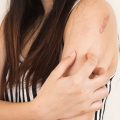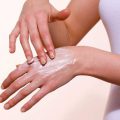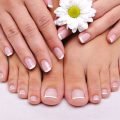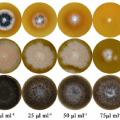- How to eliminate mold household methods
- Bleaching agents
- Vinegar, and citric acid
- Hydrogen peroxide
- Ammonia
- Baking soda
- storm
- Essential oils
- A solution of potassium permanganate
- Professional tools for removing mildew
- Tips and tricks
- Getting rid of mildew on the walls
- How to get rid of mold in the bathroom
The ideal option to get rid of mold - Overhaul of the apartment. But not everyone can afford to carry out repairs in the home, so the best remedy for mold and mildew - the use of antiseptics and special folk methods, that would avoid the scourge of its own and in a short time.
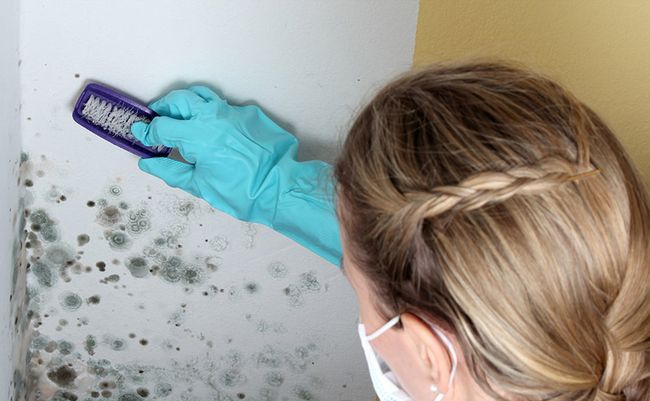
How to eliminate mold household methods
Folk remedies for mold most preferably in the fight against the fungus, tk. bring less harm to the person, will save money, and performance are often not inferior strong chemical drugs.
Bleaching agents
The composition includes sodium hypochlorite bleaches, that acts detrimental to the mold and its spores, making it an indispensable tool in the fight against any kind of fungus.
The downside of this method is the fact, that bleach is not suitable for all surfaces: tiles, bathroom, tiles and other nonporous materials bleach is easy to clean up mold, but for wood and plasterboard - it is powerless.
Treat the surface with a mold with bleach is necessary in special clothing - rubber gloves and a respirator, provided, that the room is well ventilated.
Damaged surface thoroughly cleaned of mold, and then treated with a solution of water and bleach (10:1) with a brush.
Popular home whiteners: White, ACE, Vanish.
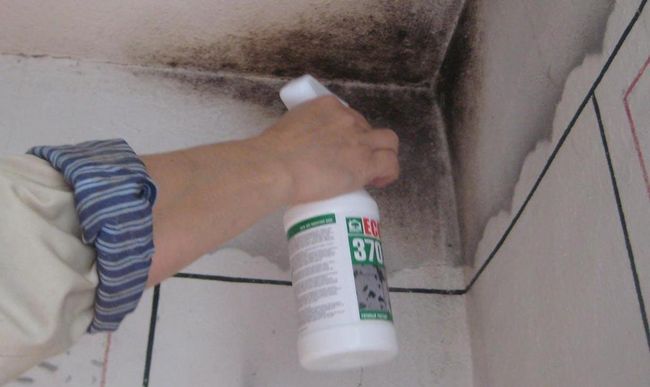
Vinegar, and citric acid
Acid, part of the vinegar, It is for most types of mold poison. Compared with bleach, Vinegar is safer, tk. it does not emit toxic fumes.
At pre-washed mold surface is sprayed from vinegar, after which the surface is rubbed with a cloth dampened. after 2-3 hours the surface was washed with water, and the room ventilated.
For best results, repeat the procedure should be several times, at intervals of 7-10 days.
In a similar manner using citric acid.
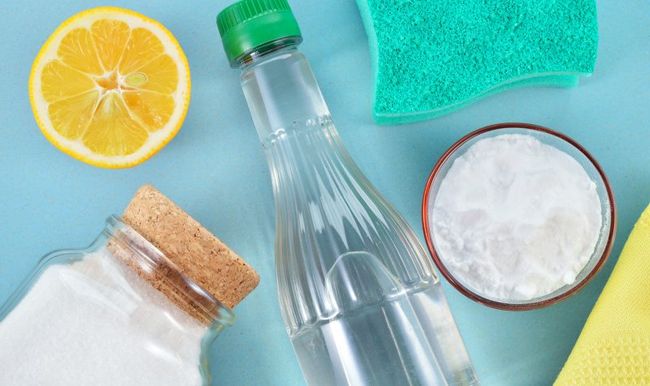
Hydrogen peroxide
Peroxide is used like vinegar - is applied to the surface for a while, then, over time, washed away.
You must use the normal of 3% peroxide, which is sold in any drugstore. But keep in mind, that peroxide has a bleaching effect, and therefore can not be used on painted surfaces.
Ammonia
By the action of ammonia is similar to bleach, ie. it is effective on hard, non-porous surfaces (tile, glass), but useless in the porous material.
Ammonia is mixed in equal proportions with water and sprayed on the surface, after 1-2 hour the solution was washed, and the room ventilated. To work with the solution must be carefully - the acrid smell of ammonia can cause headaches and dizziness. You can not use ammonia with bleach - these two substances cause reactions of toxic gases.
Baking soda
The safest way to get rid of the fungus, that does not harm any surfaces, no living beings.
In a glass of water dissolve a teaspoon of baking soda, after which this composition is sprayed the contaminated surface. After one hour, the surface may be rinsed with soda, but not completely, tk. a small amount of ash left will prevent the emergence of a new fungus.
The same solution can be treated with all the household items, located in a room with mold.
storm
It has a toxic effect on the mold and has no negative impact on human.
The bucket is poured 2,5-3 liters of water and dissolved in it a glass of borax. Work borax solution was applied to the surface with a stiff brush, while scraping the remains of the mold surface.
Desirably borax solution was applied to the surface several times and then wash it does not, tk. it will be a long time to protect against mold.
Essential oils
These means to remove the fungus will cost more, than the other home methods, but tea tree oil, rosemary and lavender oil have a strong antifungal effect, and the solution in the fight against the fungus on their basis can be stored for a long time and used by any one time.
In a glass of water dissolve a teaspoon of oil, whereupon the fungus agent is added to the atomizer and is applied to the prepared surface. Rinse with a solution should not be - it protects the wall from the mold and has, though specific, but completely harmless smell to humans.
A solution of potassium permanganate
If the mold is not to cover too vast territory, deal with it, you can use the normal potassium permanganate. For this teaspoon of potassium permanganate dissolved in a liter of water and sprayed on the infected areas. The solution is not washed away from the surface.
Important! Good effect in the fight against mold gives the following composition: water mixture, hydrogen peroxide, vinegar and boric acid in the proportions of 4:2:2:1. Such solution is sprayed on the surface, distributed after a slightly damp cloth and left to dry on the walls.
Folk remedies will not be able to quickly bring the mold - they require a longer and more regular use, but the effectiveness of their use is large enough, if a, of course, mold is not too impressed by vast tracts of space. But it is better to spend the extra time to get rid of the mold with his hands, you buy the more aggressive chemicals.
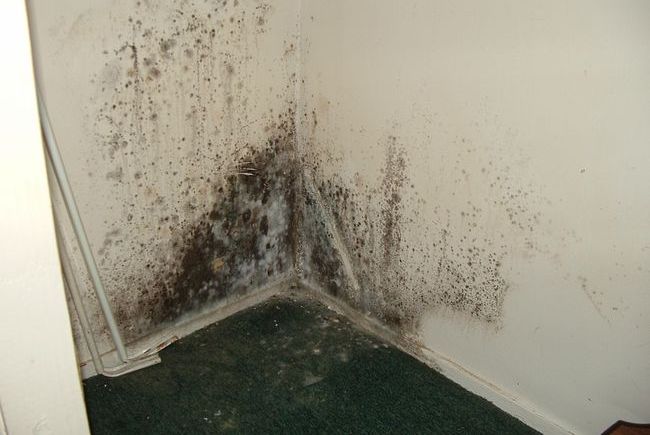
Professional tools for removing mildew
If none of the popular ways does not give the desired effect, and mold appears again and again, should consult a professional means of mold and mildew, which provide guaranteed perfect result.
Specialized formulations of mold are of two kinds - to kill the fungus and to prevent its occurrence. The most affordable and quality tools, that you can buy in stores:
- Antiplesen Express - used for treating porous surfaces (concrete, brick, plasty. It can be used independently, and added to the water-soluble paint and mortars.
- Antigribok - a non-toxic anti-mold agent for treating various types of surfaces, including wood.
- Grzybostop - disinfector deep penetration, destroys mold, long-ingrained in the wall.
- Mold remover - spray can, Effectively removes mold, but containing chlorine (ie may whiten the surface).
- mold Removal - solution, quickly eliminate black spots and fungus with plaster, wooden and concrete walls.
If the fungus "lives" in the room more than six months, require more drastic measures, how to get rid of mold:
- The walls are treated with a strong antiseptic preparations (eg, Senezh Effo or Fongiflyuid).
- Residues solution and the mold itself is scraped off by a scraper or brush dry.
- The surface was washed with warm pure water.
- On the wall is applied to the special construction primer (Touring, euro Primer), which protects the surface against the penetration of mold.
Since the mold is resistant to many antiseptics, the composition of the products from mildew and quite ruthlessly affect on the human body. Use these drugs with caution, observing safety, using protective clothing and read these instructions carefully before use.
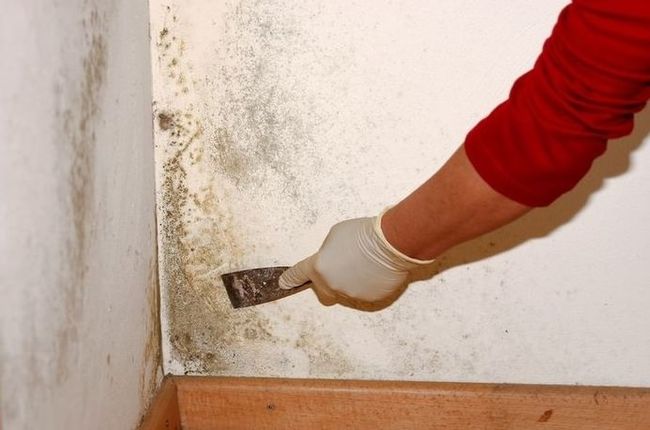
Tips and tricks
Each room has its own peculiarities mold, The approach to solving the problem may be different.
Getting rid of mildew on the walls
To mold is not got to the masonry and concrete, to begin to deal with it should immediately at the first appearance of spots. For this, first remove the damaged layer of furnish, pre-moistened surface, to spores from the fungus are not scattered all over the place. After plaque thoroughly cleaned off, and the walls are dried and processed by means of the mold.
When colored paint walls, It extends into the lower mold, therefore, the processing of the walls can start immediately after the removal of paint.
On porous materials (eg, Plasterboard) mold quickly develops in depth, therefore, to remove mold and mildew on the walls is best to use professional tools.
The wallpaper mold extends at lightning speed, so in most cases you have to completely remove wallpaper. In the initial stages of development of mold on the walls in the apartment wall can be treated with folk remedies (vinegar, potassium permanganate, essential oils). But these tools can change the wallpaper of their structure and color, so most likely will still have to change the wallpaper.
How to get rid of mold in the bathroom
Bathroom - the most vulnerable spot for mold because of the constant moisture accumulation in the joints between walls and fixtures and the seams between the tiles. In these places there is often a black coating on the sealant, which is very hard to remove.
To remove mold, you must remove the old sealant, handle wall antiseptic and apply a new hermetic wall material.
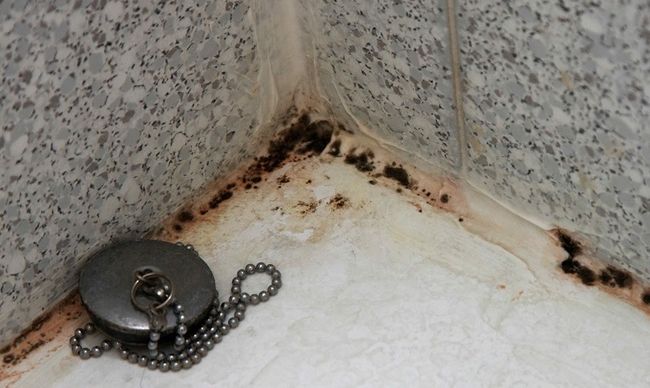
Seams between the tiles are cleaned first metal scraper, and then processed by a special grout Antiseptic composition.
For small areas of destruction process enough bathroom walls vinegar solution, soda or ammonia.
Manually remove the mold from the walls and surfaces in the apartment can only be in the case of, if complied with preventive measures to prevent the appearance of fungus - provided ventilation and dryness in the room.



